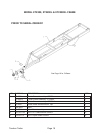
BE SURE YOU HAVE
ADEQUATE CLEARANCE FOR YOUR LOADED
TRAILER TO AVOID CONTACT WHEN
TRAVELING UNDER ELECTRICAL POWER
LINES. CONTACT CAN RESULT IN SEVERE
ELECTRICAL SHOCK OR ELECTROCUTION.
ATTACHING TRAILER WITH
BRAKES TO TOW VEHICLE
PLEASE NOTE THAT THE
SURGE BRAKES ARE TO BE USED FOR
ASSISTING IN STOPPING ONLY AND ARE NOT
TO BE RELIED ON AS THE ONLY MEANS FOR
STOPPING THE TOWED PIECE OF EQUIPMENT.
USE CAUTION AS SERIOUS INJURY OR DEATH
COULD RESULT.
Attach the towing vehicle to the trailer using a proper
sized hitch pin to handle the load being towed. Check
that safety pins are inserted properly to prevent
accidental uncoupling. Do not pull trailer if the hitch
plates are damaged. Use a safety chain as instructed
on page 8. Connect the breakaway chain from the
actuator to the tow vehicle fastening to the bumper or
hitch assembly. Allow extra slack for turning corners
but not too much slack for the chain to be dragging on
the pavement. Maintain as straight a connection to
the tow vehicle as possible. The safety breakaway
chain will only function after the hitch pin and safety
chains have failed.
NOTE: The safety breakaway chain is not to act as a
parking brake. Trailers with free backing brakes will
not hold in reverse direction. To release the
breakaway lever pry up on the spring clip to release
lever
FARM IMPLEMENT TIRES
SAFETY PRECAUTIONS
Do’s
•
DO remove the valve core and deflate the tire
before any work is performed.
•
DO use the proper and approved tools to
demount and mount the tire.
•
DO inspect all rim/wheel parts for wear, damage,
cracks, rust or mismatched components.
Destroy damaged or unserviceable parts.
•
DO inspect the tube and tire for cord or side
damage, cuts or wear. Unrepairable damaged
items must be discarded.
•
DO check for mismatched components or tire and
wheel sizes.
•
DO lubricate tire with a non-flammable tire
lubricant approved for that purpose.
•
DO place tire and wheel in inflation cage or
restraining device before inflating beyond 5 PSI.
•
DO use an extension hose with a PSI gauge and
clip on chuck when inflating the tire so you can
stand to one side.
Don’ts
•
DON’T work on a tire/wheel assembly before
removing the valve core and completely deflating.
•
DON’T re-inflate a tire that has been run flat or in
an under inflated condition before removing and
inspection.
•
DON’T reuse damaged, defective worn or
mismatched parts.
•
DON’T rework, weld, heat or braze any rim /wheel
parts for any reason.
•
DON’T inflate any tire beyond 40 PSI to seat the
beads. If beads are not seated at 40 PSI. STOP!
Deflate and determine problem.
•
DON’T hammer, strike or pry on a rim/wheel
assembly that contains any inflation pressure.
•
DON’T inflate a tire without using an inflation
cage or restraining device.
•
DON’T inflate beyond the maximum PSI specified
for the tire or rim.
Tandem Trailer Page 9
Study the Above Safety Rules
FAILURE TO HEED MAY RESULT IN SERIOUS PERSONAL INJURY OR DEATH.


















